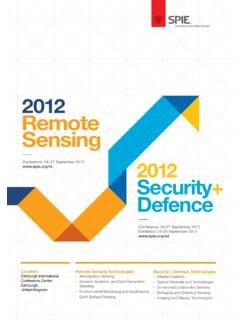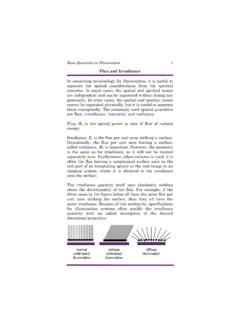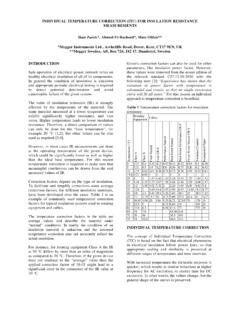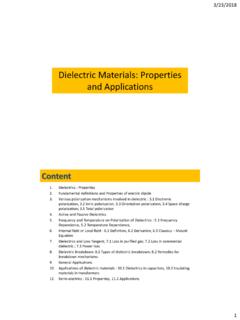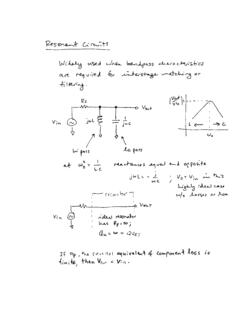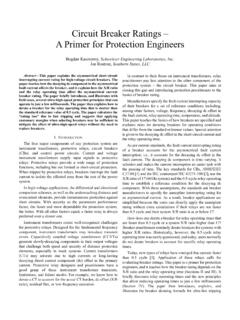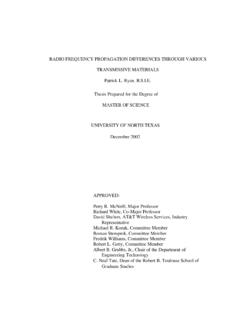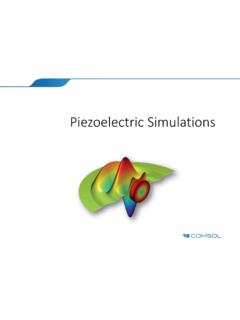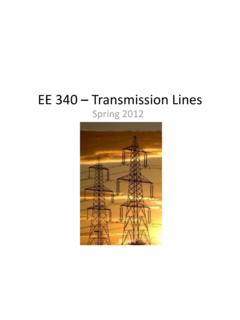Transcription of Chapter 1 Infrared Detector Characterization
1 Chapter 1 Infrared DetectorCharacterizationOver the past several hundreds of years, optical systems (telescopes, microscopes,eyeglasses, cameras, etc.) have formed their optical image on the humanretina, photographic plate, or film. The birth of photodetectors dates back to1873 when Smith discovered photoconductivity in selenium. Progress wasslow until 1905, when Einstein explained the newly observed photoelectriceffect in metals, and Planck solved the blackbody emission puzzle byintroducing the quantum hypothesis. Applications and new devices soonflourished, pushed by the dawning technology of vacuum tube sensorsdeveloped in the 1920s and 1930s, culminating in the advent of and Morton, the celebrated fathers of videonics, on the last page oftheir legendary bookTelevision(1939) concluded that: when rockets will flyto the moon and to other celestial bodies, the first images we will see of them willbe those taken by camera tubes, which will open to mankind new horizons.
2 Their foresight became a reality with the Apollo and Explorer enabled the fabrication of silicon monolithic imaging focalplanes for the visible spectrum beginning in the early 1960s. Some of theseearly developments were intended for a videophone, and other efforts werefor television cameras, satellite surveillance, and digital imaging. Infraredimaging has been vigorously pursued in parallel with visible imaging becauseof its utility in military applications. More recently (1997), the charged-coupled device (CCD) camera aboard the Hubble Space Telescope delivered adeep-space picture, a result of 10 day s integration, featuring galaxies ofthe 30thmagnitude an unimaginable figure, even for astronomers of ourgeneration.
3 Thus, photodetectors continue to open to humanity the mostamazing new IntroductionMany materials have been investigated in the Infrared (IR) field. Figure approximate dates of significant developmental efforts for infrared1materials. During the 1950s, IR detectors were built using single-element-cooled lead salt photodetectors, primarily for anti-air-missile seekers. Usuallylead salt detectors were polycrystalline and were produced by vacuumevaporation and chemical deposition from a solution, followed by a post-growth sensitization first extrinsic photoconductive detectorswere reported in the early 1950s2after the discovery of the transistor, whichstimulated a considerable improvement and growth of material purificationtechniques.
4 Since the techniques for controlled impurity introduction becameavailable for germanium at an earlier date, the first high-performance extrin-sic detectors were based on Ge:Hg with activation energy for the Hg acceptorof eV. Extrinsic photoconductive response from copper, zinc, and goldimpurity levels in germanium gave rise to devices using the 8- to 14-mm longwavelength IR (LWIR) spectral window and beyond to the 14- to 30-mm verylong wavelength IR (VLWIR) 1967 the first comprehensive extrinsic Si Detector -oriented paper waspublished by , the state of extrinsic Si was not changed signi-ficantly.
5 Although Si has several advantages over Ge (namely, a lower dielectricconstant giving shorter dielectric relaxation time and lower capacitance, higherdopant solubility and larger photoionization cross section for higher quantumFigure of the development of Infrared detectors and systems. New concepts ofdetectors developed in last two decades are marked in blue. Four generations of systemscan be considered for principal military and civilian applications: first generation (scanningsystems), second generation (staring systems with electronic scanning), third generation(staring systems with a large number of pixels and two-color functionality), and fourthgeneration (staring systems with a very large number of pixels, multi-color functionality, andother on-chip functions; , better radiation/pixel coupling, avalanche multiplication inpixels, and polarization/phase sensitivity) (adapted from Ref.))
6 3).2 Chapter 1efficiency, and lower refractive index for lower reflectance), these were notsufficient to warrant the necessary development efforts needed to bring it to thelevel of the, by then, highly developed Ge detectors . After being dormant forabout ten years, extrinsic Si was reconsidered after the invention of CCDs byBoyle and 1973, Shepherd and Yang6proposed the metal-silicide/silicon Schottky barrier detectors . For the first time it became possible to havemuch more sophisticated readout schemes both detection and readout couldbe implemented in one common silicon the same time, rapid advances were being made in narrow bandgapsemiconductors that would later prove useful in extending wavelength capa-bilities and improving sensitivity.
7 The fundamental properties of narrow-gapsemiconductors (high optical absorption coefficient, high electron mobilityand low thermal generation rate), together with the capability for bandgapengineering, make these alloy systems almost ideal for a wide range of IRdetectors. The first such material was InSb,7a member of the newlydiscovered III-V compound semiconductor family, but its operation is limitedto the mid-wavelength IR (MWIR) spectral range. The perceived requirementfor detection in LWIR band led to development of narrow-gap ternary alloysystems such as InAsSb, PbSnTe, and 10 For 10 years during the late 1960s to the mid-1970s, HgCdTe alloydetectors were in serious competition with IV-VI alloy devices (mainly PbSnTe)for developing photodiodes because of the latter s production and , development of PbSnTe photodiodes was discontinuedbecause the chalcogenides suffered from two significant drawbacks.
8 Very highthermal coefficient of expansion (a factor of 7 higher than Si) and shortShockley Read Hall (SRH) carrier lifetime. A large thermal coefficient ofexpansion lead to failure of the indium bonds in hybrid structure (betweensilicon readout and the Detector array) after repeated thermal cycling fromroom temperature to the cryogenic temperature of operation. In addition, thehigh dielectric constant of PbSnTe ( 500) resulted inRC-response times thatwere too slow for LWIR scanning systems under development at that , for two-dimensional (2D) staring imaging systems, which arecurrently under development, this would not be such a significant has inspired the development of the four generations of detectordevices (see Fig.)
9 In the late 1960s and early 1970s, first-generation linearphotoconductor arrays were developed. The first generation scanning systemdoes not include multiplexing functions in the Infrared focal plane (IRFP). Inthe mid-1970s attention turned to the photodiodes for passive IR imagingapplications. In contrast to photoconductors, photodiodes with their very lowpower dissipation, inherently high impedance, negligible 1/fnoise, and easymultiplexing on a focal plane silicon chip, can be assembled in 2D arrayscontaining more than megapixel elements, limited only by existing the invention of CCDs by Boyle and Smith,5the idea of an all-solid-stateelectronically scanned 2D IR Detector array caused attention to be turned to3 Infrared Detector CharacterizationHgCdTe photodiodes.
10 In the end of the 1970s the emphasis was directed towardlarge photovoltaic HgCdTe arrays in the MWIR and LWIR spectral bands forthermal imaging. Recent efforts have been extended to short wavelengths, , for starlight imaging in the short wavelength IR (SWIR) range, as well asto VLWIR spaceborne remote sensing beyond third-generation HgCdTe and type-II superlattice (T2SL) systemscontinue to be developed, and concept development towards the so-calledfourth generation systems was also recently initiated. The definition of fourth-generation systems is not well established.


